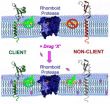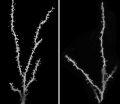(Press-News.org) HOUSTON – (Aug. 21, 2014) – An international scientific collaboration led by Baylor College of Medicine has revealed clues about genetic alterations that may contribute to a rare form of kidney cancer, providing new insights not only into this rare cancer but other types as well.
The collaboration, a project of the National Institutes of Health's Cancer Genome Atlas initiative, completed the sequence of chromophobe renal cell carcinoma and published the results today in the journal Cancer Cell.
"The Cancer Genome Atlas is a federally funded national effort that has already completed the sequence of many major types of cancer (breast, lung, ovarian, for example), but this project is now branching out to sequence more rare types of cancer," said Dr. Chad Creighton, associate professor of medicine and a biostatistician in the NCI-designated Dan L. Duncan Cancer Center at Baylor and the lead and corresponding author on the report. "The idea is that with a better understanding of these more rare types of cancers, we gain new insight that might be relevant to how we study other types of cancer. The findings in this study are a perfect example of that."
Chromophobe renal cell carcinoma is a rare type of kidney cancer, with approximately 2,000 new cases diagnosed each year in the United States. A majority of patients survive the disease.
Clinical impact
"Although most patients are reassured when the pathology of their kidney tumor comes back as chromophobe, we all have cared for patients who developed and died from metastatic chromophobe kidney cancers," said Dr. Kimryn Rathmell, associate professor of hematology and oncology in the Lineberger Comprehensive Cancer Center at the University of North Carolina at Chapel Hill and a co-senior author on the study. "This report is incredibly exciting for physicians who care for these patients because all of the treatment plans we have had to this point have been based on the biology of the more common kidney cancer type, as if chromophobe must be a close relative of that disease."
The project shows with no uncertainty that chromophobe renal cell carcinoma represents a distinct cancer entity, and reveals exciting biology inherent to the disease that we hope in the future will allow new therapies to be developed specifically for the chromophobe type of kidney cancer, Rathmell said.
The team sequenced 66 tumor samples at Baylor's Human Genome Sequencing Center. Other types of data were collected on these samples and integrated with the sequencing, including gene expression and epigenetic data. In addition to sequencing known genes, DNA from mitochondria and from the entire genome was also sequenced.
Chromosomes
A majority (86 percent) of the samples were missing one copy or a major part of chromosomes 1, 2, 6, 10, 13 and 17. Losses of chromosomes 3, 5, 8, 9, 11, 18 and 21 also were noted with significant frequencies (12 – 58 percent).
Chromosomes are the packaging of our DNA. Normally, each person receives a copy of each of 23 chromosomes from each parent for a total of 46.
When scientists looked for genes that were altered or missing, only two genes, TP53 and PTEN, were identified with a sizable frequency.
Extra step in analysis
The most surprising and significant finding came after the team took an "extra step" with their analysis, Creighton said.
"Instead of just looking specifically at the exome, we also analyzed the entire genome, something not typically done in these genomic studies," said Creighton. The exome, the part of the genome used to make proteins, constitutes only 1 percent of the total genome, where the other 99 percent is often ignored in studies.
With whole exome analysis, scientists are just looking within the boundaries of known genes, to see which are broken and may have caused the disease, he explained.
"However, when you look outside of the genes, there is much more going on," said Creighton. "For example, gene regulatory features of the genome can be altered."
TERT promoter region
From whole genome analysis, the team observed a significant amount of structural rearrangements or breakpoints involving the promoter region of a gene called TERT, which encodes for the most important unit of the telomerase complex.
Telomerase represent the "clock" of the cell, Creighton said. "This plays a critical role in cell division, and with many cancer cells, telomerase levels are really high and time never really runs out, which allows the cell to never die. "
It was the promoter region, not the actual gene, that was affected, Creighton clarified. "Since there isn't a breakdown in the actual gene, this malfunction is not picked up in whole exome analysis."
The study also raised intriguing questions about the roles of mitochondrial DNA alterations and of the cell of origin involved in cancer initiation, the authors noted.
This could signify new approaches for how scientists should conduct molecular studies of cancer, he said. "We need to survey the regulatory regions for other cancer types as well."
Data from all projects of The Cancer Genome Atlas are available for scientists around the world to study. "This effort has had a huge impact on how we study cancer as a whole," said Creighton.
INFORMATION:
Collaborators on the project include National Cancer Institute in Bethesda, MD; Harvard Medical School in Boston, Mass; Broad Institute of Massachusetts Institute of Technology and Harvard University in Cambridge, Mass; University of Southern California in Los Angeles; Samsung Genome Institute of the Samsung Medical Center in Seoul, Korea; Lineberger Comprehensive Cancer Center, University of North Carolina, Chapel Hill; Rutgers University, Piscataway, NJ; Cancer Institute of New Jersey in New Brunswick; National Institute of Environmental Health Sciences, Research Triangle Park, North Carolina; Canada's Michael Smith Genome Sciences Centre, BC Cancer Agency, Vancouver, British Columbia; University of Houston; Johann Bernoulli Institute for Mathematics and Computer Science, Intelligent Systems Group, University of Groningen, the Netherlands; Institute for Applied Cancer Science, The University of Texas MD Anderson Cancer Center; Memorial Sloan-Kettering Cancer, New York, NY; Frederick National Laboratory for Cancer Research, Frederick, MD; Weill-Cornell Medical College, New York, NY; Dana-Farber Cancer Institute, Boston, Mass.; Brigham and Women's Hospital, Boston, Mass.; Sungkyunkwan University School of Medicine, Seoul, Korea; National Institute of Supercomputing and Networking, Korea Institute of Science and Technology Information, Daejeon, Korea.
Funding for this work was provided by the National Institutes of Health (5U24CA143843 U54HG003273; R01GM103502-05; KL2TR001109; UL1TR001111; 5P50CA101942; 5P50CA101942; U54 HG003067: the Intramural Research Program of the NIH; National Cancer Institute, Center for Cancer Research with federal funds from the Frederick National Lab (HHSN261200800001E); National Institute of Environmental Health Sciences; Keck Center for Interdisciplinary Bioscience Training of the Gulf Coast Consortia (No. T15 LM007093 to; Other grant support includes the J. Randall & Kathleen L. MacDonald Kidney Cancer Research Fund; the Tuttle Family Kidney Cancer Research Fund; the Korean Health Technology R&D Project Ministry of Health & Welfare, Republic of Korea (HI13C2096) and the Korea Institute of Science and Technology Information (K-14-L01-C02-S04; KSC-2013-C3-037.)
Sequence of rare kidney cancer reveals unique alterations involving telomerase
2014-08-21
ELSE PRESS RELEASES FROM THIS DATE:
Some anti-inflammatory drugs affect more than their targets
2014-08-21
Researchers have discovered that three commonly used nonsteroidal anti-inflammatory drugs, or NSAIDs, alter the activity of enzymes within cell membranes. Their finding suggests that, if taken at higher-than-approved doses and/or for long periods of time, these prescription-level NSAIDs and other drugs that affect the membrane may produce wide-ranging and unwanted side effects.
More positively, the researchers say, their work provides the basis for a test that drug developers can use to predict and perhaps avoid these side effects in new medicines they make. A summary ...
Children with autism have extra synapses in brain
2014-08-21
NEW YORK, NY (August 21, 2014) — Children and adolescents with autism have a surplus of synapses in the brain, and this excess is due to a slowdown in a normal brain "pruning" process during development, according to a study by neuroscientists at Columbia University Medical Center (CUMC). Because synapses are the points where neurons connect and communicate with each other, the excessive synapses may have profound effects on how the brain functions. The study was published in the August 21 online issue of the journal Neuron.
A drug that restores normal synaptic pruning ...
Research explains how cellular guardians of the intestine develop
2014-08-21
Even the most careful chosen meal can contain surprises. To defend against infectious microbes, viruses or other potential hazards that find their way to the intestines, a dedicated contingent of immune cells keeps watch within the thin layer of tissue that divides the contents of the gut from the body itself.
New research at Rockefeller University sheds light on the development of a unique class of immune cells known as intraepithelial lymphocytes (IELs) that reside in this critical interface. The findings, published August 21 in Immunity, may help lead to new insights ...
Alternate mechanism of species formation picks up support, thanks to a South American ant
2014-08-21
A newly-discovered species of ant supports a controversial theory of species formation. The ant, only found in a single patch of eucalyptus trees on the São Paulo State University campus in Brazil, branched off from its original species while living in the same colony, something thought rare in current models of evolutionary development.
“Most new species come about in geographic isolation,” said Christian Rabeling, assistant professor of biology at the University of Rochester. “We now have evidence that speciation can take place within a single colony.”
The findings ...
Mouse model for epilepsy, Alzheimer's gives window into the working brain
2014-08-21
(SALT LAKE CITY)—University of Utah scientists have developed a genetically engineered line of mice that is expected to open the door to new research on epilepsy, Alzheimer's and other diseases.
The mice carry a protein marker, which changes in degree of fluorescence in response to different calcium levels. This will allow many cell types, including cells called astrocytes and microglia, to be studied in a new way.
"This is opening up the possibility to decipher how the brain works," said Petr Tvrdik, Ph.D., a research fellow in human genetics and a senior author ...
Hacking Gmail with 92 percent success
2014-08-21
RIVERSIDE, Calif. — A team of researchers, including an assistant professor at the University of California, Riverside Bourns College of Engineering, have identified a weakness believed to exist in Android, Windows and iOS mobile operating systems that could be used to obtain personal information from unsuspecting users. They demonstrated the hack in an Android phone.
The researchers tested the method and found it was successful between 82 percent and 92 percent of the time on six of the seven popular apps they tested. Among the apps they easily hacked were Gmail, CHASE ...
Researchers identify potential risk factors for urinary tract infections in young girls
2014-08-21
Winston-Salem, N.C. – August, 21, 2014 – Young girls with an intense, red, itchy rash on their outer genital organs may be at increased risk of developing urinary tract infections (UTIs), according to new research from Wake Forest Baptist Medical Center. The treatment may be as simple as better hygiene and avoiding potential irritants such as bubble baths and swimming pools.
"Vulvitis is a common condition affecting women and girls of all ages," said senior author Steve J. Hodges, M.D., associate professor of urology at Wake Forest Baptist. "We found that girls with ...
Difficulty assessing effort drives motivation deficits in schizophrenia, study finds
2014-08-21
SAN FRANCISCO, Aug. 21, 2014 – Individuals with schizophrenia often have trouble engaging in daily tasks or setting goals for themselves, and a new study from San Francisco State University suggests the reason might be their difficulty in assessing the amount of effort required to complete tasks.
The research, detailed in an article published this week in the Journal of Abnormal Psychology, can assist health professionals in countering motivation deficits among patients with schizophrenia and help those patients function normally by breaking up larger, complex tasks into ...
A NASA satellite double-take at Hurricane Lowell
2014-08-21
Lowell is now a large hurricane in the Eastern Pacific and NASA's Aqua and Terra satellites double-teamed it to provide infrared and radar data to scientists. Lowell strengthened into a hurricane during the morning hours of August 21.
When NASA's Aqua satellite passed over Lowell on August 20 at 21:05 UTC (4:05 p.m. EDT), the Atmospheric Infrared Sounder got an infrared look at Lowell's cloud top temperatures when it was still a tropical storm. AIRS showed a very thick band of thunderstorms surrounding the center of circulation and what appeared to be a very small cloud-free ...
Researchers examine impact of race and ethnicity in motor complete spinal cord injury
2014-08-21
West Orange, NJ. August 21, 2014. Researchers have published a study examining racial and ethnic influences in the outcomes of patients with motor complete spinal cord injury (SCI). The article, "Racial and ethnic disparities in functioning at discharge and follow-up among patients with motor complete SCI," was published online ahead of print on August 2 by the Archives of Physical Medicine & Rehabilitation (doi: 10.1016/j.apmr.2014.07.398). Findings included small but significant differences in self-care and mobility at discharge; no differences were apparent at 1-year ...





